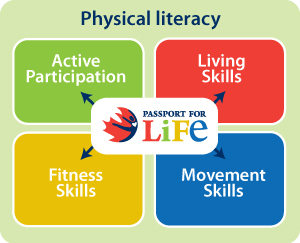Passport for Life will help you and your teacher set goals and track your progress as you build physical literacy.
About Passport for Life
The Passport for Life program includes forms and charts your teacher can use to help check your level of physical literacy now and help you make a plan to improve it! There’s also information for you to check out and take home to explain the program to your parents. Your teacher will be checking these four parts of your physical literacy:

Note: Passport for Life is only a reflection of your physical literacy (it does not equal it).
Active Participation
This section will ask how active you are. Do you do a variety of physical activities or only one type? Are you active at school? At home? In the community? Do you play in different environments, such as in water and on ice and snow? Do you play inside and outside? All these questions will help to determine the level of your physical literacy.
Living Skills
To develop in physical literacy you also have to know how to make good, healthy choices for yourself, for others and for the environment.
In the Living Skills section of Passport for Life, you’ll focus on three topics:
Feelings: How physically active are you and how do you feel (e.g., relaxed, anxious) during physical activity?
Thinking: Do you understand how to move, make better decisions and manage things to meet your goals?
Interacting: How do you cooperate, solve problems and develop relationships?
Fitness Skills
Passport for Life will check three areas of fitness: aerobic endurance, balance and core strength. When you improve in these areas, activities will be easier and more enjoyable for you to do. Becoming more physically fit will also help you to be healthier.
Movement Skills
There are many different ways to be physically active, but almost all of them make use of the same basic skills. For example, running is an important skill used in soccer, dance and tennis—just to name a few! These basic skills are called fundamental movement skills. Passport for Life will check for three of these skills (running, throwing and kicking) and will help you to improve them.
Physical Literacy and Injury Prevention
Physical literacy will also help you to avoid getting injured when you participate in a physical activity or play a sport. Why? Because physical literacy relates to better body movements and increased awareness of your physical environment.
For example, everyone thinks they know how to run, but the truth is that a lot of people run with poor body movements. Many of your classmates may run inefficiently, or in a way that increases their risk for knee or ankle injury. The same could be said for other movements such as jumping and throwing. With poor movement skills, you increase your risk of injury.
By working on your physical literacy at school, you are doing yourself a big favour. You are developing good movement skills and reducing your risk of injury. This is important for anyone who wants to have fun participating in a physical activity or sport!
